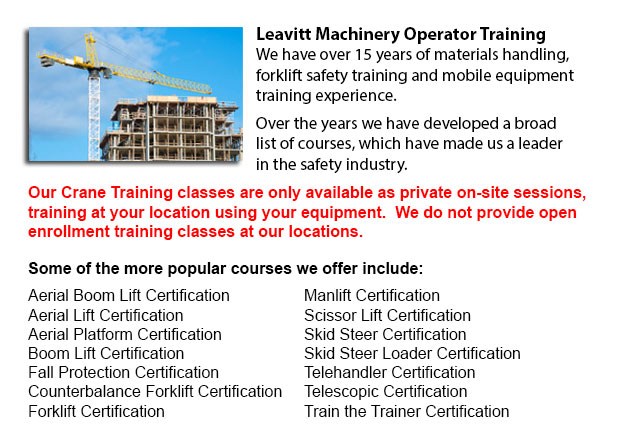
Crane Certification Oakville - The Crane Certification Program consists of the industry recommended subject matter that would teach the efficient and safe operation of cranes. The person would train in the following: pre-operational, operational and post operating requirements; how to identify cranes and their component parts; how to determine overall lift capacity; rigging components and inspection/rejection criteria; and needs specific to the work location where the people training would be operating.
The requirements that must be performed before operating a crane includes assigning authority for the pre-operational check; performing the sequential pre-operational check based on the manufacturer's specifications or specifications certified by a professional engineer; checking the log book for comments; checking the work area for obstacles and hazards; inspecting chains, cables, hooks safety latches and crane movement; making sure of the correct functioning of operational controls; and learning how to ensure the disconnect switch/isolator of the crane is correctly functioning.
Operational requirements include identifying roles and responsibilities, and determining the requirement for a formal lift plan. Trainees will be taught how to perform a danger assessment related to environmental situations, physical circumstances and staff. Subject matter includes determining when to seek competent assistance, the destination of loads and the safest route, and load weight and centre of gravity.
It is essential for individuals training to be able to identify an over-capacity lift, choose appropriate rigging machine, be aware of load limits, and determine a safe position from which to operate. Trainees will review both site-specific and universal crane signals for lifts, and techniques for traveling, lifting and loading. Right maintenance habits would likewise be covered.
Trainees would be evaluated on their knowledge of the need for emergency response procedures for various circumstances like a mechanical or electrical failure. They will be asked to describe parking and shut down procedures for safety and security, to follow tagging and lock out procedures, and to explain the reason why near misses are recorded and reported to the appropriate person. Log book records must be maintained.
People training will develop knowledge of rigging, particularly, establishing who has responsibility and authority for rigging, identifying various kinds of rigging, knowing load capacity ratings and storage procedures.
Post-operational requirements include entering deficiencies or defects, service and maintenance history in the log book, according to Federal, state and provincial codes requirements.
Site-specific needs could be incorporated into the safety training program according to the employer's needs.
-
Order Picker License Oakville
Order Picker License Oakville - Order preparation operation or order picking as it is more normally known is a method used within warehouse operations and consists of employees called order pickers. The order picker's task is to collect and take arti... More -
Forklift Operator Certification Oakville
Forklift Operator Certification Oakville - Forklift operator certification is normally needed for personnel working within industrial, warehouse or construction setting to guarantee the safe utilization of forklifts. Workplace training need to follow... More -
Scissor Lift Certification Oakville
Scissor Lift Certification Oakville - A lot of worksites and tradespeople like iron workers, welders and masons utilize scissor lift platforms to help them reach elevated work areas. The utilization of a scissor lift is usually secondary to their tra... More -
Forklift Training Courses Oakville
Forklift Training Courses Oakville - When forklift operator safety training is customized for illiteracy, training time is reduced by 50%. Train the trainer, forklift training certification and lift-truck operator driver safety training evaluation pr... More -
Manlift Training Oakville
Manlift Training Oakville - There are numerous manlift training programs which offer a review of the manlift machinery. The practicum portion of the training is one more vital portion of the course. In this section the trainee has chance to demonstra... More -
Boom Lift License Oakville
Boom Lift License Oakville - To operate an aerial boom lift, operators should be licensed through training that can be obtained utilizing both classroom sessions and practical training and by attaining a boom lift license. Instruction should be given... More -
Crane / Overhead Crane / Self-Erect Crane / Truck Mounted Crane / Hydraulic Cranes Training in Oakville
Bridge cranes or likewise called overhead cranes are actually a type of industrial material handling crane using a line and hook mechanism that runs on a horizontal beam running along two widely separated rails. Several overhead cranes could be seen... More -
Telehandler Training in Oakville
Telescopic handlers normally called telehandlers for short, are an extremely popular piece of heavy construction machinery. They are widely utilized in the construction and agricultural trades. These machines have maximum reaching ability and could g... More

Forklift Training Oakville
TOLL FREE: 1-888-254-6157
Oakville, Ontario
forklifttrainingoakville.com
Email Us
About Us


